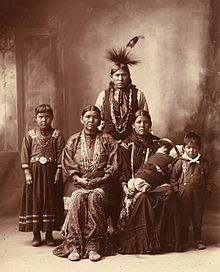
Sac Indian family photographed by Frank Rinehart in 1899.
The Sauk, an Algonquian languages people, are believed to have developed as a people along the St. Lawrence River. They were driven by pressure from other tribes, especially the powerful Iroquois League or Haudenosaunee, to migrate to Michigan, where they settled around Saginaw Bay. Due to the yellow-clay soils found around Saginaw Bay, they called themselves the autonym of Oθaakiiwaki (often interpreted to mean "yellow-earth".)
The neighboring Ojibwe and Ottawa peoples referred to them by the exonym Ozaagii, meaning "those at the outlet". French colonists transliterated that as Sac and the English as "Sauk". Anishinaabe expansion and the Huron attempt to gain regional stability drove the Sac out of their territory. The Huron were armed with guns supplied by their French trading partners. The Sac moved south to territory in parts of what are now northern Illinois and Wisconsin.
A closely allied tribe, the Meskwaki (Fox), were noted for resisting French encroachment, having fought two wars against them in the early 18th century. After a devastating battle of September 9, 1730, in Illinois, in which hundreds of warriors were killed and many women and children taken captive by French allies, Fox refugees took shelter with the Sac, making them subject to French attack. The Sac continued moving west to Iowa and Kansas. Two important leaders arose among the Sac: Keokuk and Black Hawk. At first Keokuk accepted the loss of land as inevitable in the face of the vast numbers of white soldiers and settlers coming west. He tried to preserve tribal land and his people, and to keep the peace.
Having failed to receive expected supplies from the Americans on credit, Black Hawk wanted to fight, saying his people were "forced into war by being deceived."[1] Led by Black Hawk in 1832, the mainly Sac band resisted the continued loss of lands (in western Illinois, this time.) Their warfare with United States forces resulted in defeat at the hands of General Edmund P. Gaines in the Black Hawk War.
About this time, one group of Sac moved into Missouri, and later to Kansas and Nebraska. In 1869 the larger group of Sac moved into reservations in Oklahoma, where they merged with the Meskwaki as the federally recognized Sac and Fox Nation. (The United States had been making treaties with them together since their residency in the Midwest.) A smaller number returned to the Midwest from Oklahoma (or resisted leaving.) They joined the Mesquakie at the Mesqwaki Settlement, Iowa.
Originally, the Sauk had a patrilineal clan system, in which descent and inheritance was traced through the father. Clans which continue are: Fish, Ocean/Sea, Thunder, Bear, Fox, Potato, Deer, Beaver, Snow, and Wolf. The tribe was governed by a council of sacred clan chiefs, a war chief, the head of families, and the warriors. Chiefs were recognized in three categories: civil, war, and ceremonial. Only the civil chiefs were hereditary. The other two chiefs were recognized by bands after they demonstrated their ability or spiritual power.
This traditional manner of selecting historic clan chiefs and governance was replaced in the 19th century by the United States appointing leaders through their agents at the Sac and Fox Agency, or reservation in Indian Territory (now Oklahoma). In the 20th century, the tribe adopted a constitutional government patterned after the United States form. They elect their chiefs. www.wikipedia.com
CHICCHAN
Kin 85: Red Resonant Serpent
I channel in order to survive
Inspiring instinct
I seal the store of life force
With the resonant tone of attunement
I am guided by the power of navigation
I am a galactic activation portal
Enter me.
Mantra focuses on primordial sound vibration, the primary dimension of universal coordination.*
*Star Traveler's 13 Moon Almanac of Synchronicity, Galactic Research Institute, Law of Time Press, Ashland, Oregon, 2015-2016.
The Sacred Tzolk'in
Sahasrara Chakra (Dali Plasma)




No comments:
Post a Comment